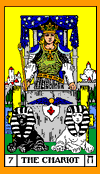
This book is out of print.

Tarot card images were included in three of Ophiel's book. He assigned THE CHARIOT to "The Art & Practice of the Occult".
This book is mostly Ophiel's background information about the five elements: earth, water, fire, air, and akasha (spirit.) The first chapters discuss the elements and their basic characteristics. The material is clearly 'borrowed' from "Nature's Finer Forces: The Science of Breath and the Philosophy of the Tattvas" by Rama Prasad, Kessinger Publishing Co., Montana. (ISBN# 1-56459-803-9.) This book was originally published in 1894.
The material covered in the book, which is mostly an introduction to the elements, their qualities, and instructions on painting a set of cards, one each for each element, following the same guidelines as presented by the Golden Dawn, and other Western systems of magick. Though Ophiel did not delve into details about how these cards can be used for more advanced work, he does instruct the student to buy a copy of "The Golden Dawn" by Israel Regardie. (Llewellyn Books), consisting of all four books in one. It is not clear whether the four books (of this Golden Dawn system)were ever offered individually. Ophiel does cover this technique in some detail in his book, "The Art & Practice of Astral Projection." The entire chapter, "The Symbol Method," is about this skrying technique. Unfortunately, Ophiel missing linking these two books to the student, telling him/her that detailed information on the technique was available in his other book.
A sidenote about the Golden Dawn book: Falcon Publishing offers another version of it, hardbound in larger page formatting, plus it was revised and reorganized by Regardie. While this edition is temporarily out of print, a revised reprinting is due the summer of 2001.
The elemental cards, sometimes called 'flashing cards,' each painted in colors opposite one another on the color wheel. When the student stares at the card, the colors will appear to lift off the page and if the student then focuses on a blank wall, the image will appear with reversed colors. For instance, the fire symbol is an up-pointed red equalateral triangle. In order to get this color to flash red, it must be painted green against a red background. The student then closes his/her eyes and the reverse-color symbol will appear. The advanced student then enlarges this image in his/her mind's eye and enters into the symbol, in his/her mind. The student is then supposed to have certain visual experiences that are supposed to reveal the sublime qualities of that element. A similar technique is used by advanced magick students, using regular Tarot cards (major arcana) as doors into other dimensions, but without the reversed color. That process is achieved when the student can envision the card in his/her mind.
The original Golden Dawn lecture on this topic can be found in the Llewellyn sixth edition, starting on page 456, "Clairvoyance."
While Ophiel did not instruct his students of this procedure in the book, he might have in his private "Sealed Lessons." In fact, even in his beginning correspondence lessons, he spends a great deal more time discussing the elements, their qualities, etc.
The elements pose as an enigma for most Western occult students without previous knowledge. While their qualities are similiar to their physical world counterparts (air, fire, water, and earth) they actually represent a finer, more ethereal force that preceeds the manifestation of their physical counterparts. According to many schools of the occult, there really is not much more to the physical world than an interaction of the four elements, plus Akasha (spirit)which is even finer than the other four. Ophiel lists the basic qualities of the elements, i.e. air is movement, fire is expansion, water is contraction, and earth is stability. Next he had the students draw them and 'meditate' on them.
Myths and legends are said to be symbolic represenations of spiritual phenomena. The only 'trick' is to indentify the story's character attributes and determine how that being fits on the Caballah. Occult truths can be studied in this way. Ophiel was big on this approach. His "Bible" was Gayley's classic "Classic Myths" text, which listed easy-access to major myths and legends.
A favorite myth of Ophiel's was the story of Oedipus and the Sphinx. The Sphinx was perched outside of Thebes and confronted travellers who passed by, presenting them with a riddle. If they answered the riddle (and nobody had at that point), they could pass. If they could not answer the riddle, they perished.
What walks on four legs in the morning, two in the afternoon, and three in the evening? The answer is man, who as a baby crawls on all fours, walks upright on two legs most of his/her life, and then, with cane in hand, walks with three legs in later years.
When Oedipus answered this question, the Sphinx perished. Ophiel (and many others) point out the taht Sphinx was comprised of four different creatures (bull, lion, eagle, and man.) These symbolize the four fixed signs of the zodiac, one for each element: Taurus, Leo, Scorpio, and Aquarius, respectively. Once Oedipus solved the riddle of the elements, he gained mastery over the physical plane.
Each inner plane, says Ophiel, has a correspondence to one of our five senses, and to solve the riddle of that plane, gains us mastery over it.
Corresponding Element and SenseMore information on the four elements can be found throughout Ophiel's writing, though most notably in his book, "The Art & Practice of Talismanic Magic" and from his [hard to find] correspondence lessons on the Foundations of Occult Knowledge.
Return to Home Page